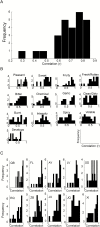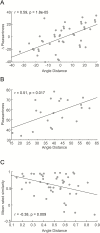SmellSpace: An Odor-Based Social Network as a Platform for Collecting Olfactory Perceptual Data
- PMID: 30873534
- PMCID: PMC6462760
- DOI: 10.1093/chemse/bjz014
SmellSpace: An Odor-Based Social Network as a Platform for Collecting Olfactory Perceptual Data
Abstract
A common goal in olfaction research is modeling the link between odorant structure and odor perception. Such modeling efforts require large data sets on olfactory perception, yet only a few of these are publicly and freely available. Given that individual odor perception may be informative on personal makeup and interpersonal relationships, we hypothesized that people would gladly provide olfactory perceptual estimates in the context of an odor-based social network. We developed a web-based infrastructure for such a network we called SmellSpace and distributed 10 000 scratch-and-sniff registration booklets each containing a subset of 12 out of 35 microencapsulated odorants. Within ~100 days, we obtained data from ~1000 participants who rated the odorants along 13 verbal descriptors. To verify that these estimates are comparable to lab-collected estimates we tested 26 participants in a controlled lab setting using the same odorants and descriptors. We observed remarkably high overall group correlations between lab and SmellSpace data, implying that this method provides for credible group-representations of odorants. We further estimated the usability of the data by applying to it two previously published models that used odorant structure alone to predict either odorant pleasantness or pairwise odorant perceptual similarity. We observed statistically significant predictions in both cases, thus further implying that the current data may be helpful toward future efforts of modeling olfactory perception from structure. We conclude that an odor-based social network is a potentially useful instrument for collecting extensive data on olfactory perception and here post the complete raw data set from the first ~1000 participants.
Keywords: odor perception; odorant descriptors; odorant pleasantness; odorant similarity.
© The Author(s) 2019. Published by Oxford University Press.
Figures








References
-
- Arctander S. 1969. Perfume and flavor chemicals: (aroma chemicals). Carol Stream (IL): Allured Publishing Corporation.
-
- Callegari P, Rouault J, Laffort P. 1997. Olfactory quality: from descriptor profiles to similarities. Chem Senses. 22:1–8. - PubMed
-
- Distel H, Ayabe-Kanamura S, Martínez-Gómez M, Schicker I, Kobayakawa T, Saito S, Hudson R. 1999. Perception of everyday odors–correlation between intensity, familiarity and strength of hedonic judgement. Chem Senses. 24:191–199. - PubMed
-
- Doty RL, Golbe LI, McKeown DA, Stern MB, Lehrach CM, Crawford D. 1993. Olfactory testing differentiates between progressive supranuclear palsy and idiopathic Parkinson’s disease. Neurology. 43:962–965. - PubMed
-
- Doty RL, Shaman P, Kimmelman CP, Dann MS. 1984. University of Pennsylvania Smell Identification Test: a rapid quantitative olfactory function test for the clinic. Laryngoscope. 94:176–178. - PubMed
Publication types
MeSH terms
LinkOut - more resources
Full Text Sources
Miscellaneous

